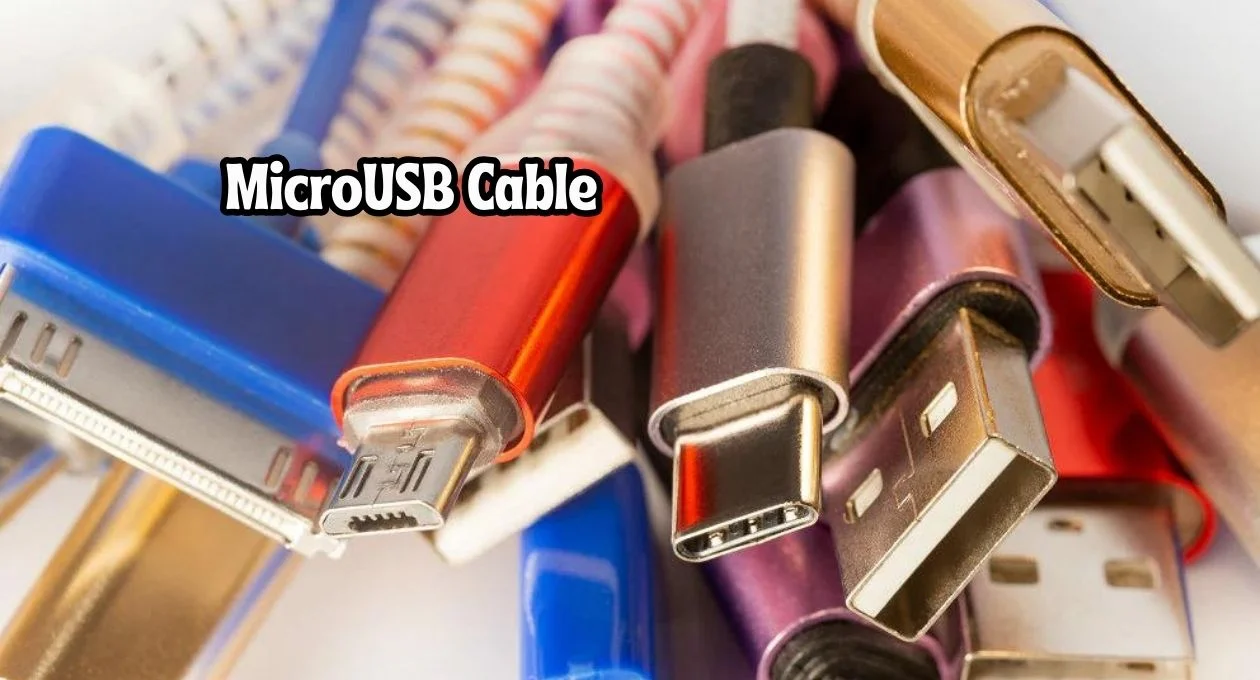In the realm of modern electronics, understanding the intricacies of microusb cable is crucial. Among the various types available, the micro USB cable stands out as a versatile and widely used option. Let’s delve into its specifics and related terms to gain a comprehensive understanding.
microusb cable are characterized by their small “micro” sized connectors, which are significantly smaller than their predecessors. These connectors typically feature a trapezoidal shape with five pins, making them especially suited for compact devices like smartphones, tablets, and portable gadgets. The standard type for these cables is the USB 2.0 Micro-B connector, which has become synonymous with charging and data transfer in myriad devices.
Apart from their size advantage, microusb cable are known for their durability and standard compliance. They support data transfer speeds of up to 480 Mbps and can carry a current of up to 1.8A, which ensures fast charging capabilities. However, their usage has gradually been declining with the advent of newer, more efficient standards like USB Type-C, which provide faster data rates, higher power delivery, and reversible connectors.
Micro-USB
The micro-USB connector is a compact and standardized interface primarily used in smartphones, tablets, and other portable devices. It features a smaller connector size compared to its predecessor, the mini-USB, and supports faster data transfer and charging capabilities.
Despite the gradual phasing out of microusb cable in favor of USB Type-C, they still hold relevance for many older devices that remain in circulation. Users continue to rely on microusb cable for their reliability, and wide availability in the market. Their low cost also makes them an attractive option for those who need functional and budget-friendly charging and data transfer solutions.
Looking ahead, while micro USB may eventually become obsolete, it serves as an important milestone in the evolution of USB technology. It paved the way for universal charging standards, significantly reducing electronic waste caused by incompatible cables and chargers. Understanding micro USB’s role in tech history provides insight into the ongoing advancements in connectivity solutions.
USB Types
USB (Universal Serial Bus) encompasses several types, each designed for specific applications. The micro-USB falls under the USB 2.0 standard, which offers reliable connectivity for data transfer and charging needs in portable devices.
USB Type-C, the successor to micro USB, has set a new benchmark with its enhanced features and benefits. Unlike micro USB’s orientation-specific design, Type-C’s reversible connector allows for effortless plugging in any direction, minimizing wear and tear. Additionally, USB Type-C supports significantly faster data transfer rates, reaching up to 10 Gbps with USB 3.1, making it ideal for demanding applications like 4K video streaming and fast file transfers.
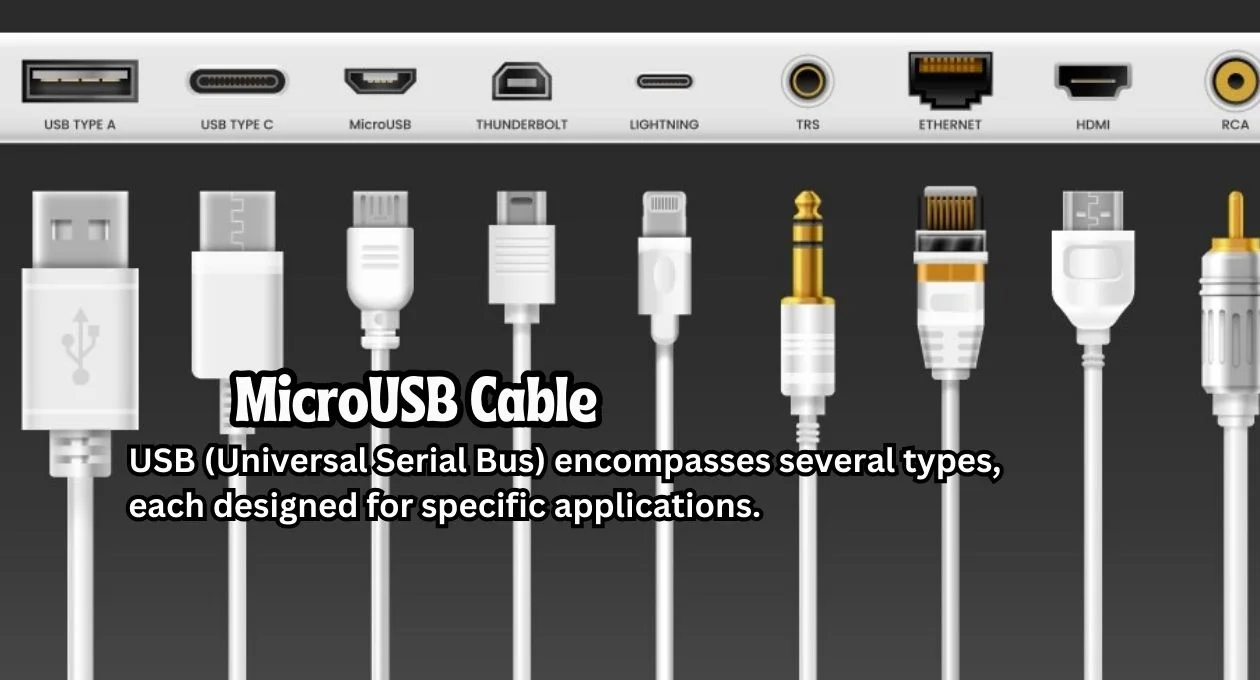
Another advantage of USB Type-C is its superior power delivery capabilities, supporting up to 100 watts of power. This not only enables rapid charging of smartphones but also extends to charging laptops and other more power-hungry devices. The versatility and future-proof design of USB Type-C underscore its adoption across a wide range of modern electronics, ensuring it will remain a standard for years to come.
Microusb Cable
A microusb cable connects devices like smartphones, cameras, and external hard drives to computers or power sources for charging and data transfer. It consists of a micro-USB connector on one end and a standard USB Type-A or Type-B connector on the other.
As devices continue to evolve, the role of various cables and connectors remains paramount in ensuring seamless connectivity and efficient power delivery. Despite the shift towards more advanced technologies like USB Type-C, the micro USB cable still retains its utility in countless households and workplaces. This endurance can be attributed to the vast number of legacy devices that rely on micro USB connectors, ensuring that users continue to need these cables for daily functions.
Manufacturers understand the importance of supporting older devices, which is why microusb cable are still widely produced and available. They serve as a bridge between the past and present, allowing users to extend the life of their gadgets without needing immediate upgrades. This transitional phase highlights the broader landscape of technological adoption, where new standards gradually replace their predecessors while still coexisting to support the diverse needs of consumers.
Micro-A USB Cable
Similar to micro-A USB cables, these variants support OTG functionality and enable direct device-to-device communication without the need for a computer.
The longevity of micro USB cables in the market underscores the consumer demand for reliable and cost-effective connectivity solutions. Even with the rise of advanced technologies, the micro USB remains a staple in many households. Its ease of use, wide availability, and adaptability to various devices make it an indispensable tool for everyday tasks. From charging phones to transferring data, the micro USB cable continues to play a crucial role in the tech ecosystem.
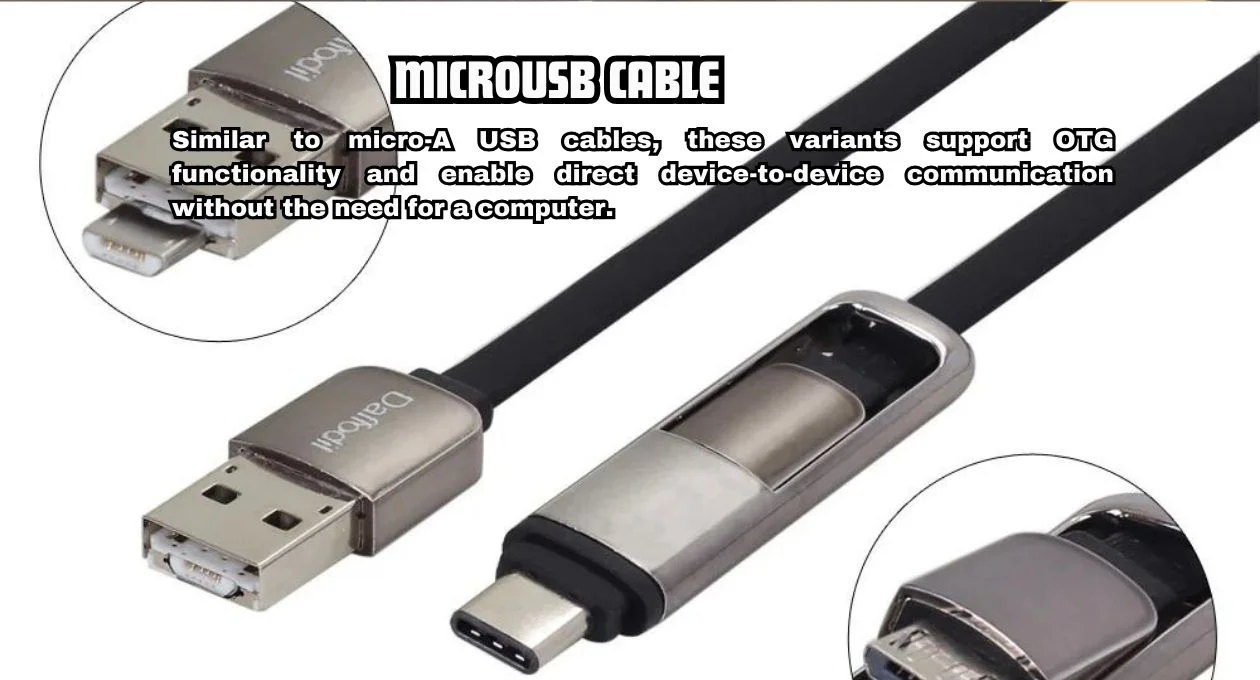
As technology progresses, the emphasis on backward compatibility ensures that older devices still function seamlessly alongside newer standards. This practice not only extends the lifespan of electronic devices but also reduces electronic waste, contributing to environmental sustainability. Consumers benefit from the flexibility of using existing cables and devices without the need for immediate upgrades, thereby promoting a more economically sustainable approach to technological advancement.
Types of USB Cables
Beyond micro-USB, other notable types include USB Type-A, Type-B, USB-C, and proprietary connectors designed for specific devices.
In the ever-changing world of technology, the rise of USB Type-C represents a significant leap forward in terms of performance and efficiency. This new standard offers faster data transfer speeds and more robust power delivery capabilities, enhancing the overall user experience. However, it’s important to recognize that the shift to USB Type-C doesn’t make older technologies obsolete overnight. Instead, it creates a transitional phase where multiple standards coexist, allowing users the flexibility to utilize both current and legacy devices as needed.
This period of transition is crucial for ensuring that users do not feel pressured to update their entire suite of devices immediately. The continued availability of micro USB cables means that people can maintain older gadgets without sacrificing functionality. Offering robust support for older connectors in tandem with introducing new standards allows for a more inclusive and sustainable approach to technological advancement. This balanced strategy helps reduce electronic waste and ensures that the benefits of new advancements can be gradually realized without rendering older devices and accessories useless.
Types of USB
Includes the entire spectrum of USB standards and connectors, reflecting the evolution from USB 1.0 to the latest USB 4.0 and beyond.
The flexibility offered by the various USB standards allows users to connect a wide array of devices with minimal hassle. Whether transferring photos from a camera, charging a smartphone, or linking peripheral devices to a computer, USB cables streamline these interactions. This seamless integration is a testament to the robust engineering and forward-thinking design that underpin the USB ecosystem.
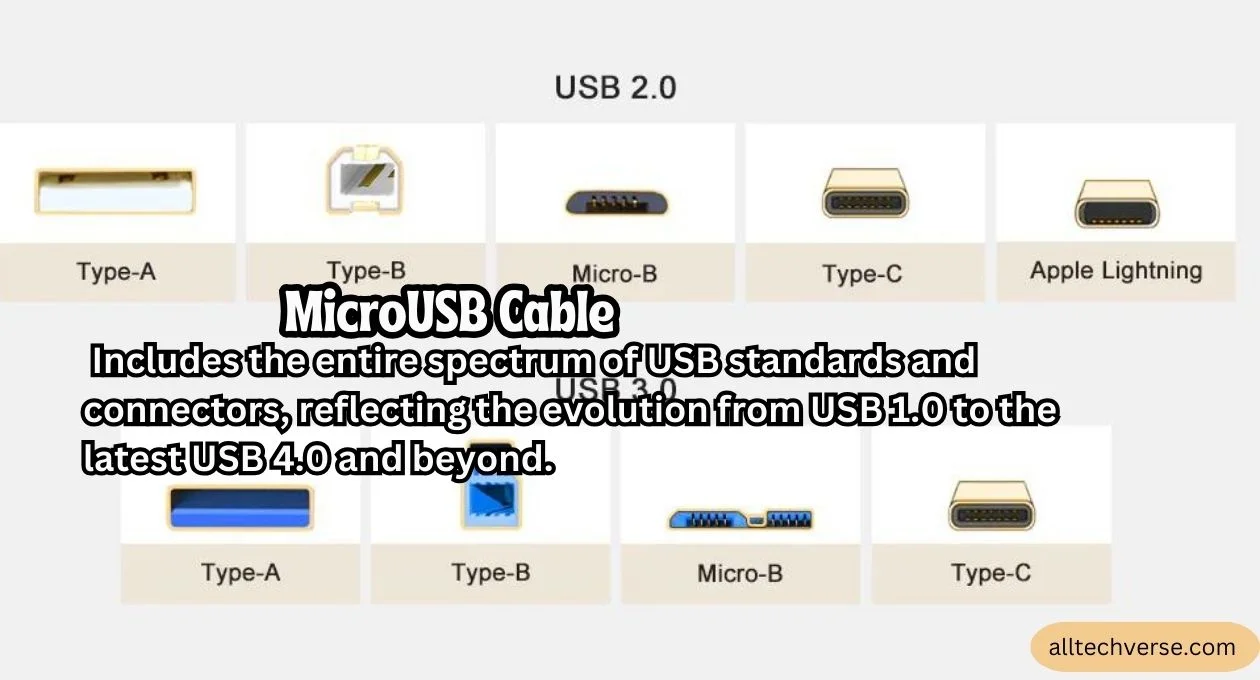
Moreover, as we progress towards more advanced technologies like USB 4.0, the aim remains to enhance user experience without alienating those who still rely on older technologies. This inclusivity ensures that individuals and businesses alike can upgrade at their own pace, reducing the financial and environmental impact of frequent, forced upgrades. By fostering compatibility and gradual transitions, the USB ecosystem continues to support a diverse range of user needs while paving the way for future advancements.
USB Plug Types
Denotes the shape and size of USB connectors, such as Type-A, Type-B, micro-USB, mini-USB, and USB-C, each serving specific functions and fitting particular device ports.
The development of USB technologies also underscores a commitment to inclusivity and accessibility. As new standards are introduced, it’s essential that they are accompanied by comprehensive support and clear guidance to help all users adapt smoothly. This approach not only minimizes confusion but also ensures that everyone, from tech enthusiasts to those less familiar with technology, can benefit from the advancements without unnecessary hurdles.
Simultaneously, the evolution of USB has spurred innovation across a myriad of related products, such as hubs, adapters, and docking stations. These tools enhance device connectivity and extend the capabilities of USB interfaces, making it easier to integrate various devices into both personal and professional environments. This supportive ecosystem strengthens the overall user experience, highlighting the importance of thoughtful and inclusive design in the realm of technological progress.
Micro USB Connector Types
Details the variations within micro-USB connectors, including differences in shape, pin configuration, and compatibility across devices.
The ongoing reliance on micro USB connectors in various devices underlines the importance of maintaining a diverse range of connectivity options in the ever-evolving tech landscape. Consumers benefit from the reassurance that their existing devices and accessories will remain compatible and functional, reducing the need for frequent replacements and minimizing electronic waste. This continuity supports a more sustainable approach to consumption, allowing users to maximize the lifespan of their gadgets.
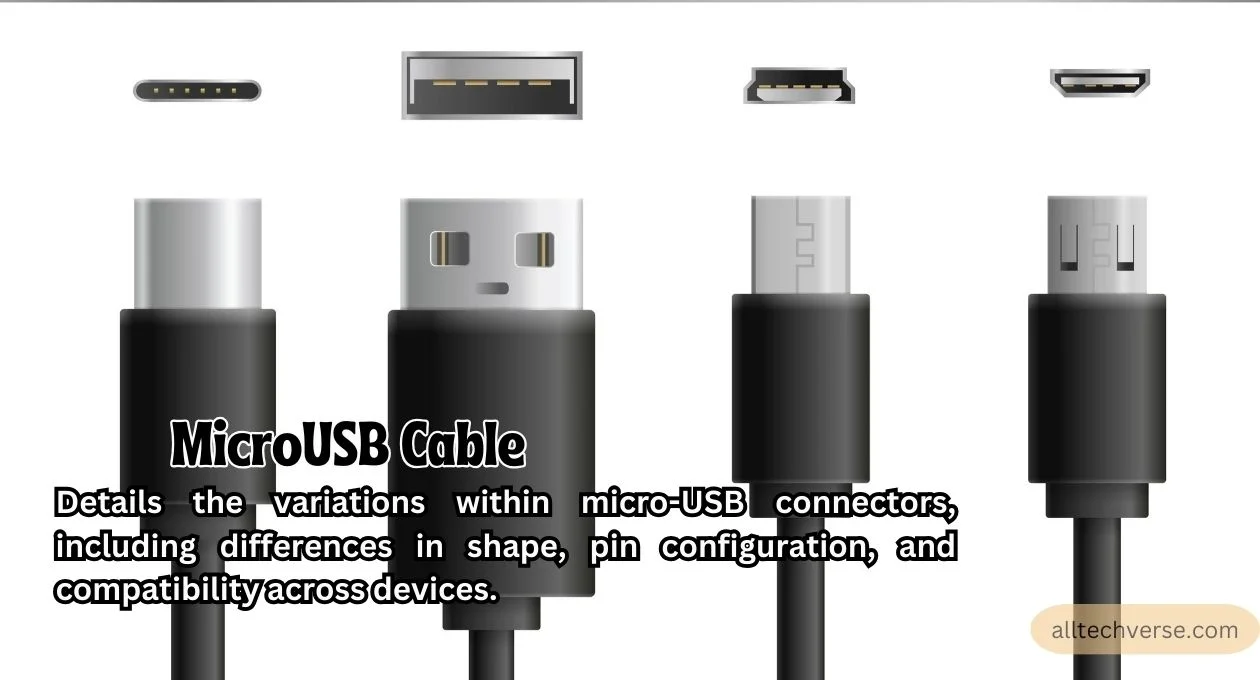
Emerging technologies must prioritize user accessibility and transitional ease to ensure widespread adoption. By continuing to support legacy connections like micro USB, alongside introducing newer standards such as USB-C, the industry can cater to both early adopters and those who prefer to upgrade at a slower pace. This inclusive strategy fosters a more cohesive and adaptable tech ecosystem, where advancements are embraced without leaving significant portions of the user base behind.
Charging Cords Types
Refers to the various types of cables used for charging devices, with micro-USB being one of the most prevalent options for older smartphones and devices.
The advent of USB-C has undeniably revolutionized the way we think about connectivity, introducing a versatile and high-performance standard that supports faster data transfer rates and more efficient power delivery. Its reversible design eliminates the frustration of aligning connectors correctly, streamlining the user experience. Additionally, USB-C’s ability to support multiple protocols through a single port, including HDMI, DisplayPort, and power delivery, significantly enhances its versatility.
Despite the growing prevalence of USB-C, it’s important to acknowledge the enduring utility of previous USB standards. Older connectors, such as Type-A and mini-USB, continue to be widely used across various devices and industries, highlighting the necessity to support these technologies. This ensures that customers can continue to use their existing equipment and reduces electronic waste by keeping perfectly functional devices in circulation.
PS4 Charger Cord
The cable used to charge PlayStation 4 controllers and other peripherals, often employing a micro-USB connector for power transfer.
The inclusion of diverse USB connector types within the tech ecosystem ensures that users have a myriad of options that cater to distinct needs and preferences. Whether it’s for fast data transfer, efficient charging, or maintaining compatibility with older devices, the variety of USB connectors plays a crucial role in enhancing user convenience. The foresight of manufacturers in sustaining compatibility across different generations of devices minimizes disruption, allowing a seamless blend of the old and new.
Additionally, the continued use and support of older USB standards highlight a commitment to sustainability by preventing unnecessary electronic waste. Consumers benefit from being able to use their existing devices without frequent upgrades, thereby reducing the environmental impact associated with producing and discarding electronic components. This balanced approach in USB technology evolution encourages a harmonious and practical adoption of new innovations while maintaining essential functionalities.
PS4 Charging Cable
Specifically designed cables for charging PlayStation 4 controllers, ensuring compatibility and reliable performance during gameplay.
As technology continues to advance, the way we interact with our devices also evolves. The incorporation of USB-C connectors in the latest gadgets signifies a shift towards more efficient, streamlined connectivity. However, the role of legacy connectors like micro-USB remains significant, accommodating users who haven’t transitioned to the latest tech. This dual support provides a balanced ecosystem that respects both innovation and user familiarity.
Furthermore, the longevity of older USB standards contributes to a more sustainable tech landscape. By ensuring that aging devices and accessories maintain compatibility with new technology, manufacturers help minimize electronic waste and extend the lifespan of their products. This approach not only supports environmental sustainability but also respects the investments users have made in their existing devices.
Micro USB vs Mini USB
Highlights the differences between micro-USB and mini-USB connectors, focusing on size, speed, and application in various devices.
One of the remarkable aspects of USB technology is its ability to unify various functions, such as data transfer, power delivery, and connectivity, into a single interface. This multifunctionality not only simplifies the design and use of devices but also fosters a more interconnected world. As USB-C becomes more prevalent, its capability to support different protocols enhances its appeal, making it an essential component in modern electronics.
Moreover, the USB ecosystem’s focus on backward compatibility has ensured a smoother transition across technological generations. Consumers appreciate not having to replace all their existing peripherals and devices whenever a new standard is introduced. This attention to compatibility not only offers convenience but also promotes a more sustainable approach to technological advancement by reducing electronic waste.
USB Micro Port
The port on devices that accepts micro-USB connectors for charging and data transfer, found on numerous smartphones, cameras, and peripherals.
The ongoing evolution of USB standards underscores the tech industry’s dedication to enhancing user experience while maintaining a commitment to sustainability. With each new iteration, users gain access to faster data transfer speeds, improved power efficiency, and greater versatility. This allows for a smoother and more efficient interaction with their devices, satisfying the increasing demands of modern technology.
Yet, the significance of legacy USB standards cannot be understated. Older connectors like micro-USB and mini-USB continue to play a crucial role in ensuring that a wide range of devices remains functional and relevant. By offering continued support for these connectors, manufacturers help users maximize the longevity of their existing equipment, ultimately contributing to reduced electronic waste and promoting a more sustainable tech ecosystem.
FAQs
Q: What is USB-C and how is it different from other USB types?
A: USB-C is a newer type of USB connector known for its reversible design, which allows it to be plugged in without worrying about orientation. It supports faster data transfer speeds, increased power delivery, and can carry multiple protocols such as HDMI and DisplayPort.
Q: Can I still use my old USB devices with new USB-C ports?
A: Yes, using appropriate adapters or cables, you can connect older USB devices to USB-C ports. Many manufacturers provide adapters to ensure compatibility across different generations of USB technology.
Q: What is the difference between micro usb and mini usb?
A: Micro-USB and Mini-USB are both smaller versions of the standard USB connector. Micro-USB is more common in modern devices and is generally smaller and more durable than Mini-USB, which was primarily used in older gadgets.
Q: How does maintaining compatibility with older USB standards benefit users?
A: Compatibility with older USB standards prevents the need for users to frequently upgrade their devices, reducing electronic waste and allowing them to get the most out of their existing equipment.
Q: Why is USB technology important for sustainability?
A: USB technology contributes to sustainability by promoting compatibility across device generations, thus minimizing electronic waste. Users can continue using their old devices with newer technology, which helps in reducing overall production and disposal of electronic components.
Q: What devices typically use Micro USB ports?
A: Micro USB ports are commonly used in smartphones, cameras, tablets, and various peripherals like external hard drives and Bluetooth speakers.
Q: Are there any limitations to using USB-C connectors?
A: While USB-C offers many benefits, it may require users to purchase new cables or adapters for connectivity with older devices. Additionally, not all USB-C cables and ports have the same capabilities, so users need to ensure compatibility for specific functions like fast charging or high-speed data transfer.
Q: What is power delivery in the context of USB-C?
A: Power Delivery (PD) in USB-C refers to a standard that allows the port to deliver higher power levels, enabling faster charging for devices such as laptops, smartphones, and tablets.
Q: How does USB-C support multiple protocols?
A: USB-C can support multiple protocols through alternate modes, allowing a single port to handle various types of connections like HDMI for video output, DisplayPort, and others, enhancing its versatility across different applications.
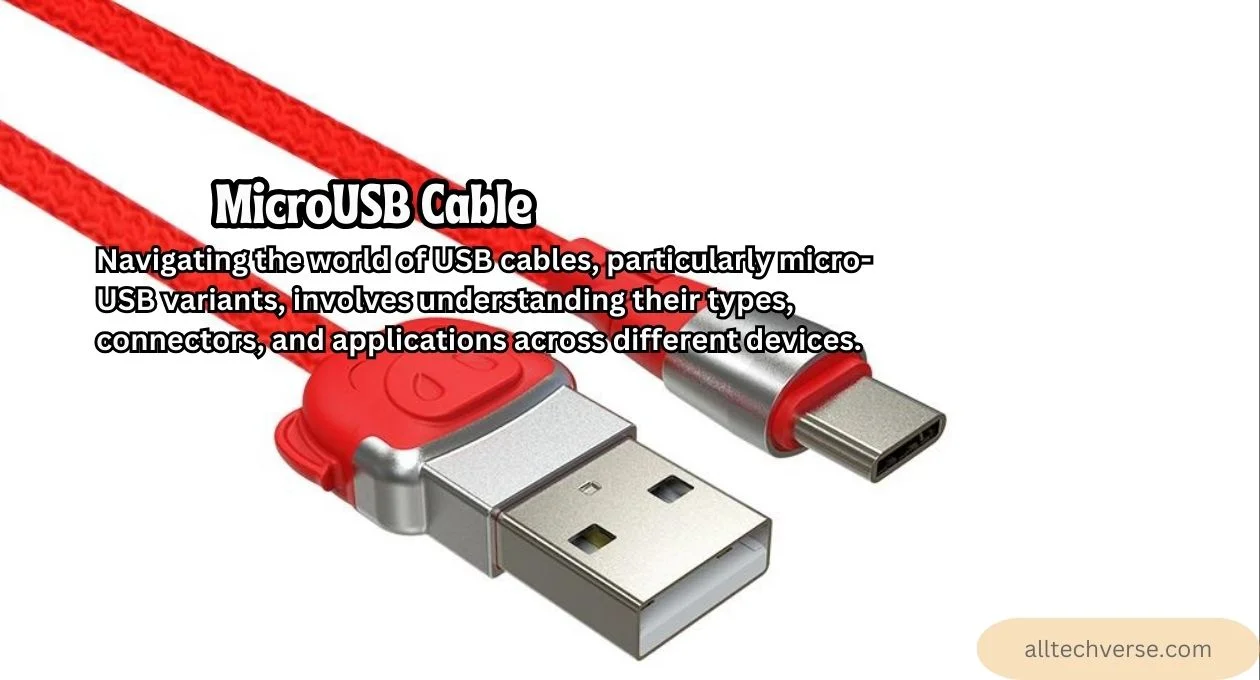
Conclusion
Navigating the world of USB cables, particularly micro-USB variants, involves understanding their types, connectors, and applications across different devices. Whether for charging your smartphone or transferring data between devices, a reliable microusb cable remains a staple in modern connectivity solutions. Stay informed to make the most of your devices’ capabilities and ensure seamless connectivity in everyday use.
As technology continues to advance, the adoption and integration of USB standards facilitate easier access and increased functionality for users worldwide. The convenience of using a single, universal interface across various devices simplifies daily tasks, from charging to data management. This integration not only saves time but also enhances productivity by ensuring swift and reliable connections. Embracing the evolving USB technologies enables us to benefit from the latest innovations while maintaining the functionality of older equipment.
For More Information Keep Visiting AllTechVerse.


